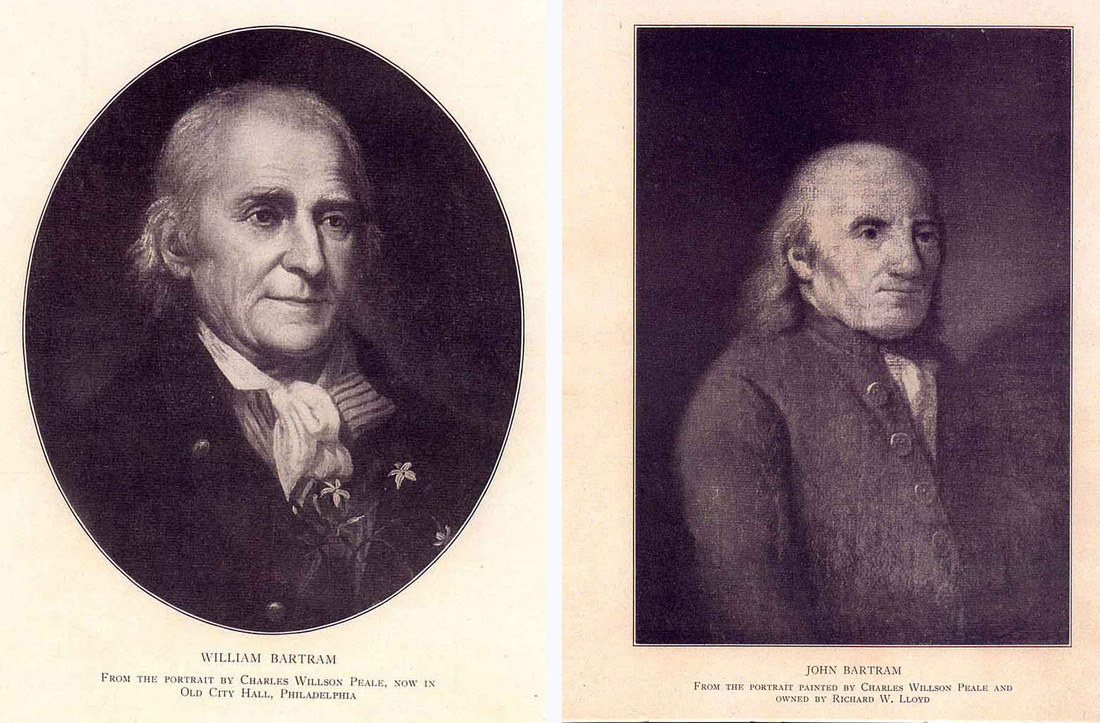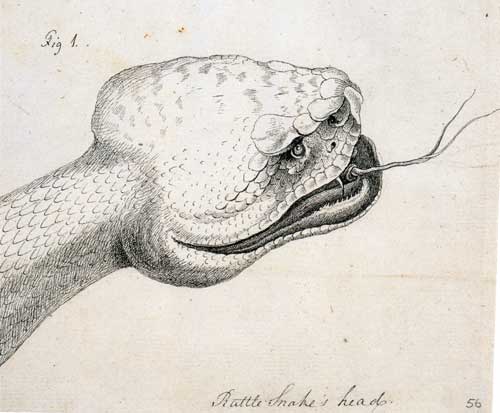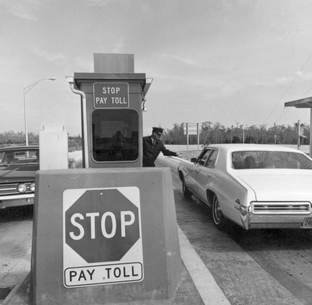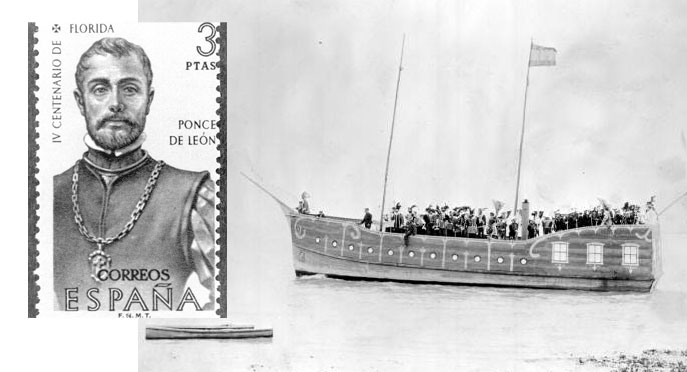April 14, 1530 - Failed conqueror Pánfilo de Narváez comes ashore
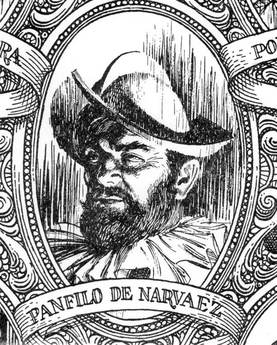 Photo: State Archives of Florida, Florida Memory
Photo: State Archives of Florida, Florida Memory
As we know, not everyone who shows up in Florida to restart their lives actually succeeds. Case in point: Spanish explorer Pánfilo de Narváez. He got a taste of success helping to conquer Jamaica and Cuba for Spain in 1509 and 1511. Then his luck begins to run out. Tasked with the governor of Spain in 1520 to arrest Hernán Cortés and replace him as commander of Mexico, Cortés instead turns most of Narváez's soldiers against him and throws and puts Narváez in prison for two years. After he is released and returns to Spain, Narváez secures a royal grant to conquer and settle Florida. But nearly a quarter of his soldiers desert him in Hispaniola in 1527. The reduced forces land in the Tampa Bay vicinity on April 14, 1528, planning to make their way to a place the Indians told them about, called Appalachen, which was supposedly teeming with gold. So after coming ashore, Narváez decides to take his 300 men and their 40 horses and head north. He orders his ships, which are carrying all of their supplies, back into the Gulf of Mexico and to sail to a harbor somewhere north, where they would all meet up later.
 Photo: State Archives of Florida, Florida Memory
Photo: State Archives of Florida, Florida Memory
Well, instead of landing at the harbor Narváez described, the ships go to another harbor where they don't find Narváez, then spend a year sailing up and down the coast before turning back to Spain. Meanwhile, Narvaez and his men resume their northward journey, but with no supplies, resort to plundering Native American villages to survive. This angers the Indians, so when Narvaez and his team finally reach the village of Appalachen, near present day Tallahassee, they are met with hostility and violence. Well, yeah. OK, so now the remaining soldiers are growing weak, and Narvaez has given up the idea of ever finding their ships. They stop at a bay on the Gulf, probably present-day St. Marks, and build five barges out of pine trees. They sew their shirts together to make sails. In September, they set sail toward a Spanish settlement in Mexico. Uh oh, storm season. Yep, the five rickety rafts are torn asunder and fewer than 100 men actually make it to an island off the cost of Texas. Narvaez was not among them. The survivors decide to walk to Mexico City. Seven years later, four arrive and tell the story of the bumbling Pánfilo de Narváez. So buck up, Floridians. It could be a lot worse.
Read more about Pánfilo de Narváez and his ill-fated mission at the University of South Florida's Exploring Florida site
Read more about Pánfilo de Narváez and his ill-fated mission at the University of South Florida's Exploring Florida site
April 13, 1951 - Marion sheriff stabbed, shot to death by suspect
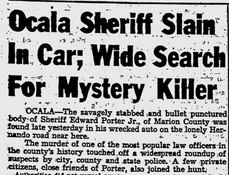
Marion County Sheriff Edward Porter Jr. was found savagely stabbed and shot to death in his wrecked car on an isolated road four miles west of Ocala. An ice delivery man came upon the sheriff's car smashed against a tree about five to six hours after the death, the St. Petersburg Times reported. The lawman had been shot five times in the neck, chest and left shoulder and stabbed six times, mostly in the abdomen, with an ice pick found on the floor of the car. Porter was last heard from at about 11 a.m. "when he notified his office he was working on a forgery case at a Negro high school," the story said. The front seat of the car, saturated with blood, showed evidence of a "terrific struggle," said a deputy who was named acting sheriff. The murder "touched off a widespread roundup of suspects by city, county and state police" and was joined by a few private citizens who were friends of the sheriff, the story said. Porter, 44, was a popular sheriff and was recently praised by a Grand Jury for cleaning up commercialized gambling in the county, the story said.
 Sheriff Edward Porter Jr.
Sheriff Edward Porter Jr.
A day later, the forgery suspect, 16-year-old Orion Nathaniel Johnson, confessed to the murder. When the state attorney asked his motive, the youth said, "I had none." Asked if he was a Communist, the youth said, "Yes," and said he killed the sheriff "because he is against my race," according to a story in the following day's paper. The 130-pound youth told investigators that Porter picked him up at the high school and took him to a clothing store where the owner identified him as the forger of a check given in payment for a white dinner jacket. The sheriff then took Johnson to his home to retrieve the jacket. At the house, Johnson picked up an ice pick and concealed it under his arm pit.
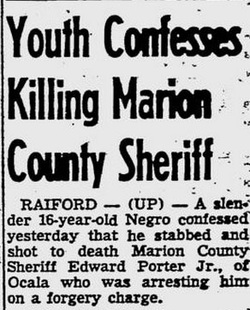
The sheriff saw the ice pick and ordered Johnson into the car. Johnson then lunged at Porter and stabbed him several times. Johnson then picked up Porter's pistol, which had fallen onto the car seat, and fired several bullets into Porter, including two at close range into the sheriff's neck. Then Johnson drove Porter's car into an open field where it went out of control and smashed into a tree. Johnson took the gun and fled on foot back to his home where he changed clothes, hid the gun, called a cab and went back to school. Johnson was convicted of the murder and executed by electrocution in 1955, according to a Marion County Sheriff's Office web page honoring fallen law enforcement officers.
Read the stories in the St. Petersburg Times: Ocala Sheriff Slain In Car; Wide Search For Mystery Killer and Youth Confesses Killing Marion County Sheriff • Read the account by the Marion County Sheriff's Office: Honoring Those Who Have Fallen
Read the stories in the St. Petersburg Times: Ocala Sheriff Slain In Car; Wide Search For Mystery Killer and Youth Confesses Killing Marion County Sheriff • Read the account by the Marion County Sheriff's Office: Honoring Those Who Have Fallen
April 12, 1981 - Columbia launches America back into space

Following a frustrating delay two days earlier, the United States' Space Shuttle program began as Columbia embarked upon its first mission. It would be the first of 135 missions involving five shuttles over 30 years. The launch put Americans back into space for the first time since the final Apollo mission in 1975. President Ronald Reagan watched on television from the White House as he recovered from an assassination attempt. Members of the public jammed the area around Kennedy Space Center to get a view of the spectacle at 7 a.m. on Sunday morning. The scheduled launch the Friday before was scrubbed by a computer problem, disappointing half a million spectators and frustrating astronauts John Young and Robert Crippen. Young set a record by becoming the first human to go into space five times. He had flown on the first manned Gemini mission in 1965 and would pilot one more shuttle flight in 1983. Read the story in the Sarasota Herald-Tribune: Shuttle Sails Flawlessly Into Heavens • Check out NASA's multimedia retrospective on the Space Shuttle program
April 11, 1986 - FBI shootout in Dade leads cops to seek more heat
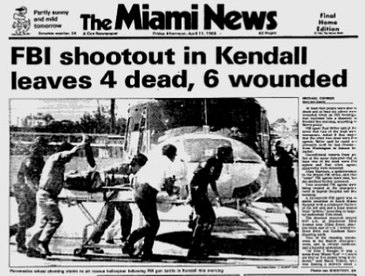
A shootout between eight FBI agents and two serial bank robbers in unincorporated Dade County ended with two agents dead and five wounded and prompted law enforcement agencies to seek more powerful handguns. Despite outnumbering the suspects four-to-one, the bank robbers pinned down the FBI agents in part because the agents were using revolvers while the robbers had a shotgun and a semi-automatic rifle. One of the suspects was able to continue firing his weapon despite sustaining multiple gunshots from the agents. Both suspects died, but an FBI review of the incident determined that the agents were disadvantaged because most were armed with revolvers. The incident, which has been portrayed on several television shows and is infamous in law enforcement circles, accelerated a trend of police agencies around the nation switching from revolvers to semi-automatic pistols. Read more at Miami Daily News: FBI shootout in Kendall leaves 4 dead, 6 wounded
April 10, 1766 - John Bartram ends journey to Carolinas, Ga., Florida
|
The founder of modern naturalism and botany officially concluded his journey through the Carolinas, Georgia and Florida on this date in 1766. We know this because it's part of the title of a John Bartram manuscript, "Diary of a Journey Through the Carolinas, Georgia and Florida, from July 1, 1765 to April 10, 1766" published as part of the series, Transactions of the American Philosophical Society in 1942.
|
John Bartram was a Quaker and highly-regarded botanist who traveled the wilderness of the American colonies with a goal of documenting all the natural flora of the New World. In 1765, when he was in his 60s, King George III named him the Royal Botanist in America and sent him with his 26-year-old son, William, to explore East and West Florida, which had been ceded to England by Spain two years earlier. Florida had become the subject of fascination in London and potential investors were seeking information about developable lands.
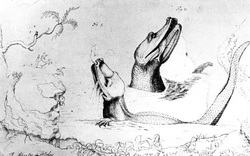 Alligators sketched by William Bartram
Alligators sketched by William Bartram
After traveling through the Carolinas and Georgia on horseback, the Bartrams spent nearly two months exploring the St. Johns River by canoe. John analyzed the quality of soil, plants and trees along the river, while William sketched pictures of plants and animals they saw. Afterward, John stayed in St. Augustine and converted his diary entries into a travel journal that was widely read in England and inspired aristocrats and merchants to acquire tracts of land in East Florida. Those investments led to the plantation era in Florida, which irrevocably changed the face of the river valley that the Bartrams had so carefully observed and recorded.
|
William returned to East Florida in 1774 and spent eight months traveling the St. Johns River in a small sailboat. In 1991, he published his own journal, Travels Through North and South Carolina, Georgia, East and West Florida, the Cherokee Country, the Extensive Territories of the Muscogulgees, or Creek Confederacy, and the Country of the Chactaws. Sections of that book recounting William's Florida travels were widely read throughout Europe and helped shape the romanticized view of the state's natural treasures that continues to inspire explorers today.
|
Read more about the Bartrams' travels through Florida:
• Florida History Online: John Bartram’s Travels on the St. Johns River, 1765-1766
• Florida Museum of Natural History: Florida Naturalists - William Bartram
• Bartram's Garden - 18th Century Home of John Bartram Naturalist & Botanist & Explorer.
• Florida History Online: John Bartram’s Travels on the St. Johns River, 1765-1766
• Florida Museum of Natural History: Florida Naturalists - William Bartram
• Bartram's Garden - 18th Century Home of John Bartram Naturalist & Botanist & Explorer.
April 9, 1921: Whites expelled from West Palm Beach 'colored town'
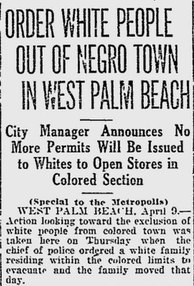
A West Palm Beach judge ordered a white family living in the African American section of the city to vacate their home, the Miami Daily News reported. The action preceded a decision by the city manager not to grant a white businessman a license to operate a store in "colored town." "White sentiment" in general is against "the encroaching of white people in the colored section," the story said. But in addition, "negroes, leading citizens of the section, have begun to ask the question: 'Why should we be barred from white town if the white people are allowed to reside within our limits and conduct businesses here?'" Yes. Why indeed? Read the story in the Miami Daily News: Order White People Out of Negro Town in West Palm Beach
April 8, 1923 - News heats up about 'lost' Tamiami trail blazers
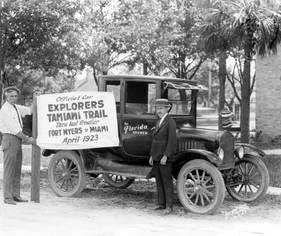 Photo: State Archives of Florida, Florida Memory
Photo: State Archives of Florida, Florida Memory
It was a saga that drew news coverage not unlike today's lost Malaysian airliner story -- but with a likely happier ending. When 24 Southwest Florida men set out on April 4, 1923 to drive across the Everglades to Miami on an unpaved trail, newspapers reported they expected to complete the trip in three days. The men, mostly Fort Myers civic and business leaders, embarked upon the drive to publicize the need for state funding to pave the "Tamiami Trail" through the Everglades. When the 10-car motorcade failed to arrive by April 6, Miami papers declared the group lost -- and began a week of stories documenting efforts to locate the group with unsuccessful search parties and airplane expeditions, mixed with speculation about likely hunger, battles with wild animals, savage Indians, and other dangers of the brutal Florida swamp.
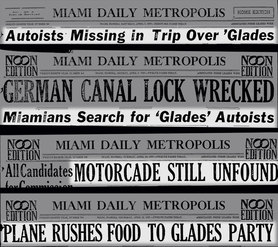
In reality, the men always knew where they were and had assistance of Seminole guides familiar with the Everglades. But the team did face hardship. Three cars broke down. The men ran out of food, and some were injured while swinging axes to construct "cordoroy roads" out of tree trunks so their cars could traverse impassable sections of the swamp. By April 12, three men who had broken away from the group on foot reached a camp of road graders who were working west from Miami. They reported that the group was safe but hungry, prompting Miami civic leaders to send a plane with food, cigarettes and coffee. All of the men arrived in Miami to great fanfare on April 21. A news documentary company filmed a re-enactment of the arrival, and Miami threw a parade on Flagler Avenue. The publicity generated by the trip worked. Funding to pave the road through the Everglades was obtained, and the paved Tamiami Trail opened in 1928. The explorers went into the history books as the "Tamiami Trail Blazers."
Read more about the Tamiami Trail Blazers:
• Miami Daily News, April 10, 1923: Miami Party Searching for Fort Myers Motorcade Finds Impassable Barrier
• Miami Daily News, April 12, 1923: Plane Rushes Food to Glades Party
• April 1973 reproduction of American Eagle newspaper from April 26, 1973: History
Making Motorcade Hewed Path Through Last Frontier
• Florida Memory blog, April 25, 2013: Allen H. Andrews, Trail Blazer
• Florida Historical Quarterly: Tamiami Trail Blazers: A Personal Memoir by Russell Kay
• Sarasota Herald-Tribune story, July 6, 1995: Tamiami Trail Blazers recall adventure across Everglades
• Miami Daily News, April 10, 1923: Miami Party Searching for Fort Myers Motorcade Finds Impassable Barrier
• Miami Daily News, April 12, 1923: Plane Rushes Food to Glades Party
• April 1973 reproduction of American Eagle newspaper from April 26, 1973: History
Making Motorcade Hewed Path Through Last Frontier
• Florida Memory blog, April 25, 2013: Allen H. Andrews, Trail Blazer
• Florida Historical Quarterly: Tamiami Trail Blazers: A Personal Memoir by Russell Kay
• Sarasota Herald-Tribune story, July 6, 1995: Tamiami Trail Blazers recall adventure across Everglades
April 7, 1890 - Everglades crusader Marjory Stoneman Douglas born
|
Marjory Stoneman Douglas, the "Grande Dame of the Everglades," whose 1947 book, "Everglades: River of Grass" reshaped the public's conception of the Everglades from a useless swamp to a vital component of the world's ecosystem, was born in Minneapolis. After graduating from Wellesley College in 1912, she moved to Florida in 1915 to escape an unhappy marriage and took a job writing for the Miami Herald, where her father was an editor. She lived through the 1928 hurricane that killed nearly 2,000 people. After "Everglades: River of Grass" was published, she helped lead the successful push to have nearly 1.6 million acres designated as a national park. She founded Friends of the Everglades in 1970 and led her hundreds-strong army of supporters to oppose projects that would further erode the subtropical wetlands.
|
|
"We're fighting the Federal Government, the U.S. Army Corps of Engineers, water management, realtors and demographics," she was quoted in a Time magazine profile in 1982. Still, she earned respect from her adversaries at all levels of government. President Bill Clinton phoned her on her 103rd birthday and awarded her the Presidential Medal of Freedom a few months later. While the building that houses the state Department of Natural Resources in Tallahassee bears her name, she remained in the same Coral Gables house from 1926 until her death in 1998. It had no air conditioning, no television, and she never learned to drive a car, the Sarasota Herald-Tribune reported in its May 15, 1998 obituary. Read Stoneman Douglas' obituary in the Sarasota Herald-Tribune: 'Glades Crusader • Read a 1982 Time magazine profile: Lady of the Everglades
|
April 6, 1959 - Seminoles vote to support building 'Alligator Alley'
|
The governing council of the Seminole Tribe approved a resolution approving construction of a major expressway linking Florida's east and west coasts through the heart of the Everglades. Officially called "The Everglades Parkway," most people know it today as Alligator Alley. The tribal council's vote indicated the council was willing to grant right-of-way across the Big Cypress Reservation. The tribe also decided that the expressway would be good for business in Big Cypress. Alligator Alley opened in 1969 as an extension of Interstate 75.
|
April 5, 1925 - 'Great Miami Tornado' kills 5, wrecks 250 homes
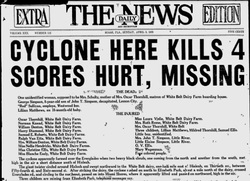
A tornado that was later estimated to have spawned winds between 158 mph and 207 mph lumbered across a 10-mile stretch of then-rural Dade County, killing five, hospitalizing 35 and destroying an estimated 250 homes along its quarter-mile wide path. The human toll was small compared to what would have happened to the same area today. Much of the destruction occurred at White Belt Dairy, a half-mile east of Hialeah, where buildings, trucks, cars and livestock were obliterated. The funnel turned toward residential communities north and northwest of Miami, killing three and injuring many others.
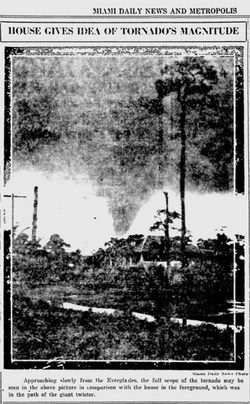
Because the cyclone formed at around 1 p.m., thousands could see it in the distance and were able to escape by driving away or abandoning their vehicles. Witnesses described seeing cars picked up and carried a considerable distance through the air. The Miami Daily News published an "Extra Edition" later that afternoon with vivid descriptions, including one of a man at the dairy picked up, "whirled high in the air" and "dashed to the ground" where his body was found two miles away "torn to pieces." Two cows were killed at the dairy, the story said, adding, "Trees were uprooted, and a shower of dead chickens fell in Elizabeth Park and along other places in the path of the twister." A.J. Kipple of Elizabeth Park was driving toward his home with his two sons in his car when they saw the approaching twister. The three jumped out of the car and took cover in a clump of palmettos by the road as they watched the twister pick their car up and smash it to the ground, demolishing it. The tornado eventually moved out to northern Biscayne Bay before dissipating. Read the story in the Miami Daily News: Cyclone Here Kills 4, Scores Hurt, Missing • Read an account in the April 1925 edition of the Monthly Weather Review • Read a review of tornados in South Florida: South Florida tornadoes: Could a Joplin-type twister hit here?
April 4, 1933: NASCAR 2nd generation leader Bill France Jr. is born

There was "Big Bill" France and "Little Bill" France. "Big Bill" was an auto mechanic who founded the National Association for Stock Car Auto Racing in 1947 as a mostly small-town Southern sport that was kicked off each year with a wild race on the hard-packed sands of Daytona Beach. "Little Bill," born in Washington D.C. a year before his parents moved to Daytona Beach, grew up in the sport, traveling with his father from race to race, doing necessary grunt work and even driving a race car for a time. Bill France Jr. became head of NASCAR when "Big Bill" retired in 1972, 13 years after the opening of the Daytona International Speedway and the end of beach racing.
Under Bill France Jr.'s leadership, NASCAR expanded into one of the nation's most popular spectator sports, drawing national television audiences rivaling those for National Football League games. In 1979, he signed a deal with CBS Sports to televise the entire Daytona 500 live for the first time, then 20 years later oversaw the signing of a $2.4 billion television contract with Fox, NBC and TNT, which required replacing the sport's longtime title sponsor - Winston cigarettes - with the Nextel phone company. NASCAR's headquarters remains in Daytona Beach, where the organization was born. Besides NASCAR, the France family owns International Speedway Corp. and holds controlling interest in 13 race tracks, including Daytona International Speedway and Homestead Miami Speedway. Tens of thousands of fans bring millions of dollars to Florida three times a year for the sport's season opening and ending races and a midseason race over the July 4 holiday weekend. "Little Bill" France died in 2007 at 74.
Read Bill France Jr.'s obituary in the New York Times: Bill France Jr., 74, Dies; Gave Nascar Its National Reach
Under Bill France Jr.'s leadership, NASCAR expanded into one of the nation's most popular spectator sports, drawing national television audiences rivaling those for National Football League games. In 1979, he signed a deal with CBS Sports to televise the entire Daytona 500 live for the first time, then 20 years later oversaw the signing of a $2.4 billion television contract with Fox, NBC and TNT, which required replacing the sport's longtime title sponsor - Winston cigarettes - with the Nextel phone company. NASCAR's headquarters remains in Daytona Beach, where the organization was born. Besides NASCAR, the France family owns International Speedway Corp. and holds controlling interest in 13 race tracks, including Daytona International Speedway and Homestead Miami Speedway. Tens of thousands of fans bring millions of dollars to Florida three times a year for the sport's season opening and ending races and a midseason race over the July 4 holiday weekend. "Little Bill" France died in 2007 at 74.
Read Bill France Jr.'s obituary in the New York Times: Bill France Jr., 74, Dies; Gave Nascar Its National Reach
April 3, 2006: Gators win first-ever basketball title vs. UCLA, 73-57

After starting the college basketball season with a 17-0 record, a Florida Gator basketball team without stars swept through the NCAA Tournament and became the first Division 1 team from the state to win the national basketball championship by beating UCLA in the title game, 73-57, in Indianapolis' Hoosier Dome. At 40, Billy Donovan became the second-youngest coach among active coaches to win a national title. At the time, Florida became only the seventh school to win national championships in basketball and football. But the milestones were only beginning. The Gator football team that took the field the following fall went on to beat Ohio State for the BCS National Championship, making the Gators the first program ever to hold football and men's basketball titles at the same time. Then the Gators basketball team won another national championship in 2007, also by beating Ohio State, to become the first-ever school to win football and basketball championships in the same year by defeating the same school. They also became the first-ever school to win back-to-back basketball championships with the same starting five. Read the story in the St. Petersburg Times: Florida defeats UCLA 73-57 for its first NCAA basketball championship • Read the story on espn.com: Florida first to hold football, hoops titles at same time • Read the story in the New York Times: Gators Repeat as National Champions
April 2, 1513 - Spanish explorer Juan Ponce de Leon lands in Florida
|
Spanish explorer Juan Ponce de Leon is credited with coming ashore and claiming "La Florida" for Spain on this date in 1513. While it has long been accepted that de Leon landed with his three caravels near St. Augustine and became the first European of record to see the peninsula, scholars have recently challenged details of that historical account.
|
Mariner Douglas Peck used modern navigational technology to conclude de Leon actually landed on Melbourne Beach and published his conclusion in Florida Historical Quarterly in 1992. As a result, both St. Augustine and Melbourne Beach commemorated the 500th anniversary of the landing last year. Ponce de Leon's name became linked to Florida history commercially in 1882 when Henry Flagler opened Hotel Ponce de Leon in St. Augustine. The city sanctioned a Ponce de Leon celebration in 1907. The notion that he searched for a "Fountain of Youth" is now accepted as myth. Native American associations protested last year's commemorations by pointing out that Ponce de Leon sought to enslave native peoples he found here. And some scholars argue that he was not the first European in Florida and was preceded by Portuguese or English explorers.
Read the story in the Sarasota Herald-Tribune: Ponce de Leon landed where? • Read an alternative view of Ponce de Leon's discovery of Florida in the New York Times: Ponce De Leon Exposed
Read the story in the Sarasota Herald-Tribune: Ponce de Leon landed where? • Read an alternative view of Ponce de Leon's discovery of Florida in the New York Times: Ponce De Leon Exposed
April 1, 1926: Air Mail service begins in four Florida cities
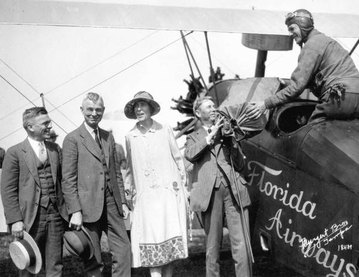 Photo: State Archives of Florida, Florida Memory
Photo: State Archives of Florida, Florida Memory
Regular air mail service was established in Florida as "Miss Miami" flew from Miami to Fort Myers and Tampa with 3,514 letters and Miami's Postmaster J.D. Gardner on board, the Miami Daily News reported. The Florida Airways plane picked up more mail and another postmaster in Fort Myers before landing in Tampa, where it was greeted by Tampa's Postmistress Elizabeth Barnard and a number of local officials. At Tampa, 6,000 pieces of mail were transferred to another plane, the "Miss Tallahassee" for delivery to Jacksonville. Postmistress Barnard boarded that plane, then flew to Miami aboard "Miss Jacksonville" with Jacksonville Postmaster Herbert Ross.
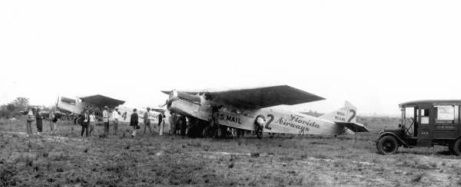 Florida Airways planes begin mail service
Florida Airways planes begin mail service
The U.S. Post Office contracted the air mail service with Florida Airways under the Kelly Act of February 2, 1925. The act was intended to "encourage commercial aviation" by authorizing the Postmaster General to contract with airlines to carry mail. The contractors would receive 80 percent of the revenue from the mail they carried. The early airlines also carried passengers, but none could have survived more than a year without the revenue from the mail contracts, according to the Smithsonian's National Postal Museum website. Florida Airways established regularly scheduled passenger service between Miami, Jacksonville and Tampa on June 1, 1926.Founded in 1923 by Eddie Rickenbacker and two partners, Florida Airways failed to turn a profit and ceased operations in June 1927. Its mail routes were taken over by the company that later became Eastern Airlines, and its planes were purchased by the forerunner to United Airlines. Read the story in the Miami Daily News: 'Miss Miami' Mail Plane Reaches Tampa • Check out the Smithsonian's National Postal Museum website entry: Building the Commercial Aviation Network

